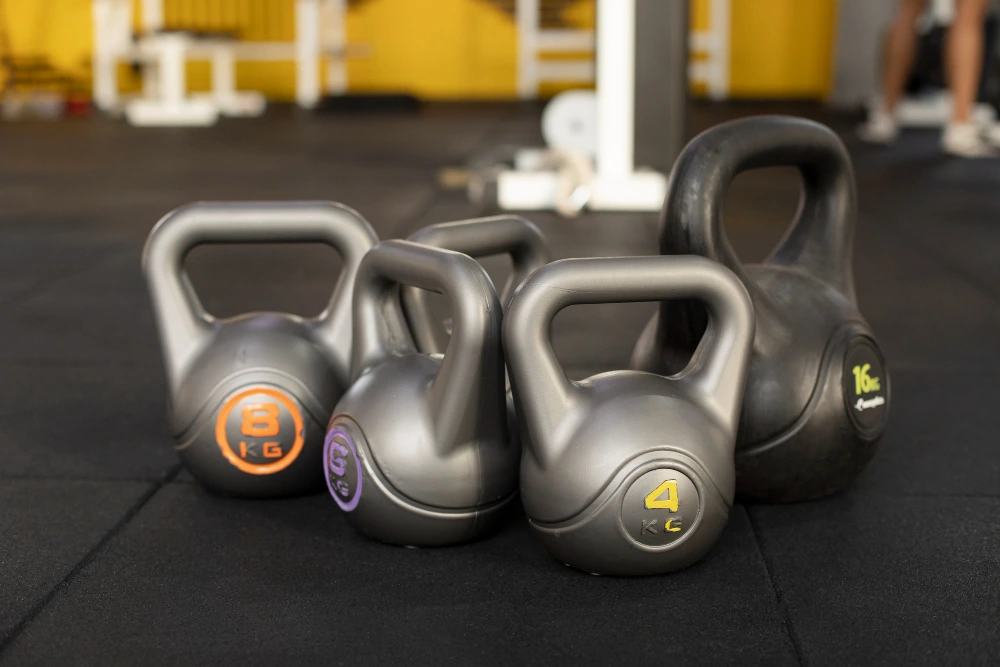Gym Weights: Unlock Your Strength for Superior Fitness

Do you want to get stronger and healthier? Gym weights can help you reach your fitness goals. It doesn’t matter if you are new to exercise or have done it before, using gym weights can make a big difference.
In this article, we will show you how to use weights in your workouts. We will talk about different types of weights like dumbbells, barbells, kettlebells, and medicine balls. You will learn how to lift weights correctly, try different weight exercises, and stay safe to avoid getting hurt.
We will also explain how lifting weights can make you fitter and stronger. With our tips, you will get stronger muscles, better muscle tone, and more energy.
Get ready to make your workouts better with gym weights. It’s easy to start, and the results are great. Let’s begin your fitness journey today.
Table of contents
- The Importance of Gym Weight Training in Fitness
- Understanding Different Types of Gym Weights
- How to Choose the Right Weight for Your Fitness Goals
- Proper Form and Technique for Weightlifting
- The Benefits of Progressive Overload in Weight Training
- Designing a Weightlifting Program for Optimal Results
- Common Mistakes to Avoid When Lifting Weights
- Incorporating Weight Training into Your Overall Fitness Routine
- Tips for Staying Motivated and Consistent with Weightlifting
- Conclusion: Unlock Your Strength and Achieve Superior Fitness Results
- You May Also Like
- Frequently Asked Questions
The Importance of Gym Weight Training in Fitness

Weight training is essential for building strength, toning muscles, and boosting overall fitness. It offers many long-term benefits for your health. Here’s why you should add weight training to your fitness routine:
1. Building Strength
Lifting weights helps you build and keep muscle mass. This is important as you get older because muscle mass decreases naturally. Strength training exercises like squats, deadlifts, and bench presses work multiple muscle groups. This makes you stronger and more capable of performing daily activities easily.
2. Improving Muscle Tone
Regular weight training helps define and sculpt your muscles. This gives you a toned and fit look. You can target specific muscle groups, such as your arms, legs, or core. This leads to a balanced and pleasing physique.
3. Increasing Bone Density
Weight training is one of the best ways to increase bone density and prevent osteoporosis. When you lift weights, your bones build more bone mass. This strengthens them and reduces the risk of fractures and bone-related conditions.
4. Enhancing Metabolic Rate
Weight training boosts your metabolic rate. This means you burn more calories even when resting. This is great for weight management and fat loss. The more muscle mass you have, the higher your resting metabolic rate. This helps you maintain a healthy weight.
5. Reducing Risk of Injuries
Strengthening your muscles and bones makes your body more resilient and less prone to injuries. Weight training also improves your balance, coordination, and flexibility. This further protects you from falls and other accidents.
6. Mental Health Benefits
Weight training isn’t just good for your body; it’s great for your mind too. Exercise, including weight training, releases endorphins. These are natural mood lifters. Regular weight training can help reduce anxiety and depression, improve self-esteem, and promote better sleep.
7. Cardiovascular Health
While weight training mainly targets your muscles, it also benefits your cardiovascular system. Combining weight training with aerobic exercises can improve your heart health, lower blood pressure, and reduce the risk of heart disease.
8. Functional Fitness
Weight training helps you perform everyday tasks better. Activities like lifting groceries, climbing stairs, or playing with your kids become easier when you have strong muscles. Functional fitness focuses on exercises that mimic real-life movements. This improves your overall quality of life.
Adding weight training to your routine can greatly improve both your physical and mental health. Whether you want to build strength, tone your muscles, or enhance your overall well-being, weight training can help you achieve your fitness goals.
Understanding Different Types of Gym Weights
Gym weights come in various forms, each serving different purposes. Here’s a quick rundown:
- Dumbbells: Versatile and perfect for both beginners and advanced lifters. Great for targeting specific muscle groups.
- Barbells: Ideal for heavier lifts and compound movements like squats, deadlifts, and bench presses.
- Kettlebells: Excellent for dynamic movements, improving strength, flexibility, and endurance.
- Medicine Balls: Useful for functional training and adding variety to your workouts.
How to Choose the Right Weight for Your Fitness Goals
Choosing the right gym weight depends on your fitness goals:
- Strength Building: Opt for heavier weights with fewer repetitions.
- Muscle Endurance: Choose lighter weights with higher repetitions.
- Toning: A moderate weight with a balanced number of repetitions.
Always start with a weight you can handle comfortably and gradually increase as you get stronger.
Proper Form and Technique for Weightlifting
Maintaining proper form is essential to prevent injuries and get the most out of your workouts. Here are some tips:
- Keep your back straight: Avoid rounding your back.
- Engage your core: This helps stabilize your body.
- Breathe properly: Exhale during exertion and inhale during relaxation.
- Control the movement: Avoid using momentum to lift weights.
The Benefits of Progressive Overload in Weight Training
Progressive overload involves gradually increasing the gym weight, frequency, or number of repetitions in your strength training routine. This method ensures continuous improvement and helps you avoid plateaus. By consistently challenging your muscles, you’ll see gains in strength and muscle size.
Designing a Weightlifting Program for Optimal Results
An effective weightlifting program should include:
- Warm-Up: Always start with a warm-up to prepare your muscles.
- Compound Exercises: Focus on exercises that work multiple muscle groups.
- Isolation Exercises: Target specific muscles for balanced development.
- Cool Down: Finish with stretching to improve flexibility and recovery.
Common Mistakes to Avoid When Lifting Weights
To get the best results and stay safe, avoid these common mistakes:
- Lifting too heavy too soon: Start with manageable weights.
- Ignoring form: Focus on technique rather than the amount of weight.
- Skipping warm-up or cool down: Both are crucial for injury prevention.
- Not resting enough: Allow your muscles time to recover.
Incorporating Weight Training into Your Overall Fitness Routine
Balance is key. Combine gym weight training with cardiovascular exercises, flexibility work, and proper nutrition. This holistic approach ensures overall fitness and helps you reach your goals more effectively.
Tips for Staying Motivated and Consistent with Weightlifting
Staying motivated can be challenging, but here are some tips:
- Set clear goals: Know what you want to achieve.
- Track your progress: Keep a workout journal.
- Mix it up: Vary your routine to keep things interesting.
- Find a workout buddy: Partnering with someone can boost motivation.
Conclusion: Unlock Your Strength and Achieve Superior Fitness Results
Mastering gym weights is a journey that needs dedication and consistency. By understanding the importance of weight training, choosing the right weights, maintaining proper form, and using progressive overload, you can unlock your strength and achieve superior fitness results. Stay motivated, be patient, and remember that every workout brings you one step closer to your goals. Start your fitness journey today, and let gym weights transform your body and mind.
You May Also Like
Frequently Asked Questions
Using gym weights helps build muscle strength, improve bone density, enhance metabolic rate, and reduce the risk of injuries. It also contributes to better muscle tone and overall fitness.
Choose weights based on your fitness goals. For strength building, use heavier weights with fewer repetitions. For muscle endurance, opt for lighter weights with higher repetitions. Always start with a weight you can handle comfortably and increase gradually.
The main types of gym weights are dumbbells, barbells, kettlebells, and medicine balls. Each type serves different purposes and can be used to target various muscle groups and workout styles.
Maintain a straight back, engage your core, breathe properly, and control your movements. Avoid using momentum to lift weights and focus on the muscle being worked to prevent injuries and maximize effectiveness.
Progressive overload involves gradually increasing the weight, frequency, or number of repetitions in your strength training routine. It ensures continuous improvement, helps you avoid plateaus, and promotes gains in strength and muscle size.